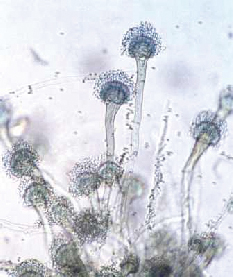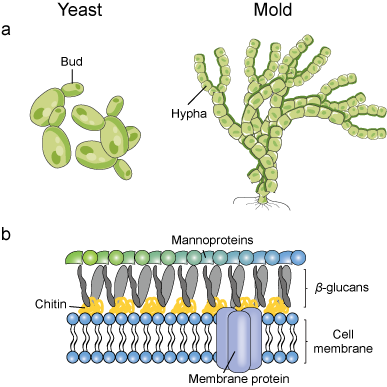Fungal Antigens
Fungi Background

Related Resources
Infection Immunity
Infectious Disease ELISA kit
General Characteristics of Fungi
Fungi are microorganisms in the domain eukarya. They show less differentiation than plants, but a higher degree of organization than the prokaryotes bacteria. The kingdom of the fungi (Mycota) comprises over 50 000 different species, only about 200 of which have been identified as human pathogens. Only about a dozen of these “pathogenic” species cause 90% of all human mycoses. Many mycotic infections are relatively harmless, for instance the dermatomycoses. In medical mycology, fungi are classified according to practical aspects as dermatophytes, yeasts, molds, and dimorphic fungi. Molds grow in filamentous structures, yeasts as single cells and dermatophytes cause infections of the keratinized tissues (skin, hair, nails, etc.). Dimorphic fungi can appear in both of the two forms, as yeast cells or as mycelia.
Two morphological forms of fungi are observed (Figure 1.):
Hypha: this is the basic element of filamentous fungi with a branched, tubular structure, 2–10 um in width.
Mycelium: this is the web structure of hyphae. Substrate mycelia (specialized for nutrition) penetrate into the nutrient substrate, whereas aerial mycelia (for asexual propagation) develop above the nutrient medium.
Fungal thallus: this is the entirety of the mycelia and is also called the fungal body or colony.
Yeast: the basic element of the unicellular fungi. It is round to oval and 3– 10 um in diameter. Several elongated yeast cells chained together and resembling true hyphae are called pseudohyphae.
Dimorphism: some fungal species can develop either the yeast or the mycelium form depending on the environmental conditions, a property called dimorphism. Dimorphic pathogenic fungi take the form of yeast cells in the parasitic stage and appear as mycelia in the saprophytic stage.
 Figure 1. Fungi morphology and fungal membrane structure.
Figure 1. Fungi morphology and fungal membrane structure.
General Aspects of Fungal Disease
Besides fungal allergies and mycotoxicoses, fungal infections are by far the most frequent fungal diseases. Mycoses are classified clinically as follows:
- — Primary mycoses.
- — Opportunistic mycoses.
- — Subcutaneous mycoses.
- — Cutaneous mycoses.
Little is known about fungal pathogenicity factors. The natural resistance of the macroorganism to fungal infection is based mainly on effective phagocytosis whereas specific resistance is generally through cellular immunity. Opportunistic mycoses develop mainly in patients with immune deficiencies.
Mycogenic Allergies
The spores of ubiquitous fungi continuously enter the respiratory tract with inspirated air. These spores contain potent allergens to which susceptible individuals may manifest strong hypersensitivity reactions. Depending on the localization of the reaction, it may assume the form of allergic rhinitis, bronchial asthma, or allergic alveolitis.
Mycotoxicoses
Some fungi produce mycotoxins, the best known of which are the aflatoxins produced by the Aspergillus species. These toxins are ingested with the food stuffs on which the fungi have been growing. Aflatoxin B1 may contribute to primary hepatic carcinoma, a disease observed frequently in Africa and Southeast Asia.
Mycoses
Data on the general incidence of mycotic infections can only be approximate, since there is no requirement that they be reported to the health authorities. It can be assumed that cutaneous mycoses are among the most frequent infections worldwide. Primary and opportunistic mycoses are, on the other hand, relatively rare. Opportunistic mycoses have been on the increase in recent years and decades, reflecting the fact that clinical manifestations are only observed in hosts whose immune disposition allows them to develop. Increasing numbers of patients with immune defects and a high frequency of invasive and aggressive medical therapies are the factors contributing to the increasing significance of mycoses.
Hot Products